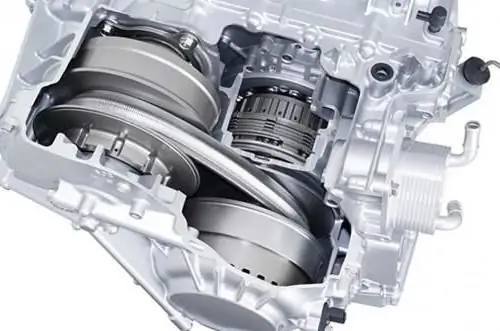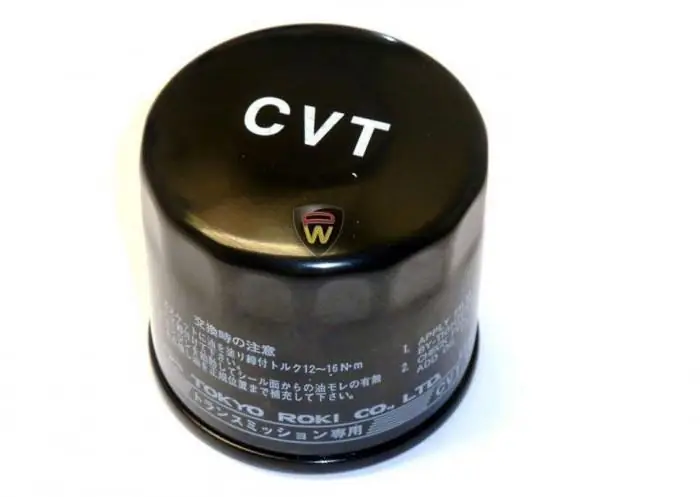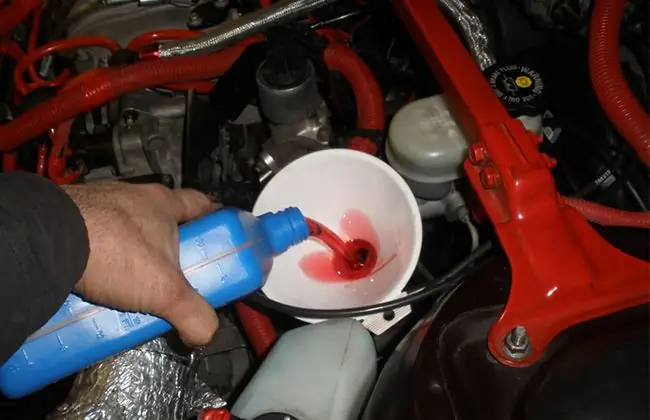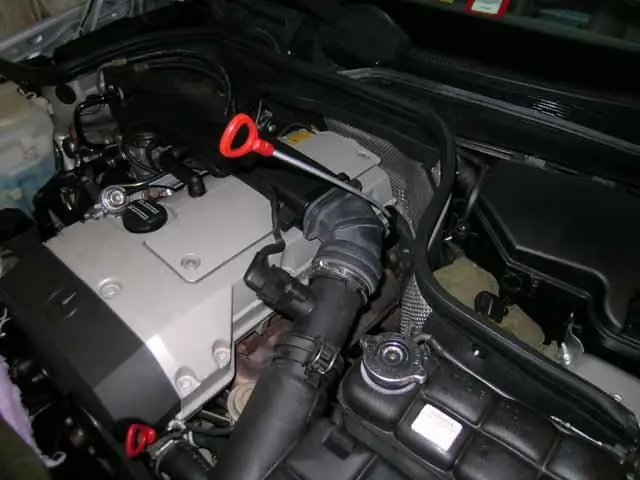2025 Author: Erin Ralphs | [email protected]. Last modified: 2025-01-22 21:14:12
As you know, any engine needs cooling. But few people know that not only the motor, but also the box is subjected to temperature loads. And often the machine heats up. For this purpose, automatic transmission oil coolers are installed on many machines. Volvo is equipped with it from the factory. What is this element, how to install it and what are its features? We will talk about this in our today's article.
Features of the automatic transmission cooling system
There is oil in every gearbox. However, in an automatic, unlike mechanics, it is designed to transmit torque. Lubricant for automatic transmission is more liquid and is labeled ATP. In mechanics, an almost jelly-like liquid with a viscosity of 85W90 (or so) is filled in, in which a black tint predominates. Why such differences? It's all about how the box works. The oil in the mechanics is filled only in the sump. Gears during rotation are dipped into this bath and thus lubricated. In the automatic transmission, everything is different. Here, a torque converter (or "donut") is used as a clutch. Inside it there are two impellers. They interact with each other due to the directed flow of oil. That is, the lubricant performs the function of transmitting torque.

Accordingly, the liquid is constantly in motion and heats up. But overheated oil can damage the box. It is necessary that the ATP liquid be heated to 75-80 degrees. Already at 100, changes in viscosity and other characteristics begin. As a result, the automatic transmission resource is reduced by 2-3 times.
Why do I need an automatic transmission oil cooler?
As we said earlier, the liquid in the box is constantly heated. And to prevent overheating, you need a heat exchanger. It is the radiator that keeps the operating temperature, preventing overheating of the oil and gearbox.
Where is it?
Depending on the design features, the automatic transmission oil cooler can be located in the box itself (in the pan) or be integrated into the main heat exchanger. The last scheme is more thoughtful and versatile.

However, this method of placement has its downsides. For example, if one of the two heat exchangers in the housing breaks down, antifreeze and oil will mix together. And the price of such a radiator is an order of magnitude higher. On dismantling it can be bought for 5-10 thousand rubles.
Device
Automotive oil cooler for automatic transmission consists of the following elements:
- Top tank.
- Core.
- Lower tank.
- Fasteners.
The main purpose of the element is to cool the liquid entering it. Typically, the tanks and core are made of brass. As practice shows, this material has an excellentthermal conductivity and, accordingly, has a high efficiency.

The core consists of thin plates arranged transversely. Through them pass vertical tubes. They are soldered to the plates and are non-separable. The oil passing through the core diverges into many streams. This ensures rapid cooling of a large volume of liquid. The oil cooler is connected to the automatic transmission using pipes. They are usually made of rubber.
Additional automatic transmission oil cooler: is it worth installing?
All cars that come with automatic transmission are already equipped with an ATP-fluid heat exchanger. But practice shows that such radiators do not always cope with their task. Especially often owners of turbocharged cars - Subaru, Toyota, etc. - face overheating of the box. Therefore, the question arises of installing an automatic transmission oil cooler on top of the main one.
Start installation
What do we need for this? In addition to the heat exchanger itself, it is worth purchasing fasteners and oil-resistant reinforced hoses 1.5 meters long.

We also need an oil thermostat. We need it so that in winter the liquid does not supercool. The oil in the automatic transmission should operate in a mode from 75 to 90 degrees Celsius. Anything below or above these values is invalid. Please note that when installing an additional automatic transmission oil cooler (universal or not, it does not matter),It is necessary to include a thermostat in the circuit. It will block cold oil flows. Thus, the liquid will warm up to operating temperatures faster in winter, and you will drive a workable warm box.
Let's consider the features of the installation on the example of the car "Subaru Forester". So, first we need to decide on the installation scheme. Experienced motorists do not recommend installing an additional heat exchanger in the intake line of the factory cooler. This solution is useless, since at the exit from the factory radiator we will get a hot ATP liquid heated to 95-100 degrees. But how to install it? The most correct option is to install the element in the return line, which is on the way from the factory radiator to the automatic transmission.

Having de alt with the installation scheme, we proceed to dismantle the body cladding. First you need to remove the headlight from the driver's side and the bumper. Next, remove the tube from the expansion tank and remove the mounts of the main radiator. It is installed on the front panel.
Since we also have an air conditioner radiator nearby, we cannot allow both coolers to be next to each other. To do this, we use 3 mm spacers and glue Teflon plates on the fasteners of the additional automatic transmission radiator. During installation, the element may stand up skewed. To avoid this, it is necessary to cut the plastic clips of the ties. During installation, the latter must pass through the cells of the air conditioner cooler and the standard heat exchanger. On thethe output of the screed is fixed with a cap. Such fastening is carried out at four points.
But the installation of the automatic transmission oil cooler does not end there. Next, you need to remove the radiator tank. It is attached with two bolts. Then unscrew the three screws securing the fan bracket. So we get free space for tightening the hats from the inside of the radiator. On the right side of the bumper we see two oil lines. We need a refund. It is easy to recognize it - it is further from the "stern". When removing the pipe, be prepared for splashing ATP fluid. It is better to plug it with a homemade stopper or substitute a clean container under the hose. Next, connect the oil thermostat. It is not necessary to drill fasteners - it is enough to fix it on two construction ties.
Final works
After the automatic transmission oil cooler has been connected, we check the reliability of all connections. Do not start the car until the oil level in the box has been checked. Since another coolant has appeared in the system, the ATP fluid level may drop. So, add oil to the transmission and start the engine. The assembly of the cladding should be continued after making sure that the system works correctly.

Check the temperature in all four hoses (for this it is better to use a pyrometer). If everything is correct, turn off the engine and assemble the lining in the reverse order.
Prevention
In order for the additional radiator to last as long as possible, you should know the preventive measures. Periodically it is recommended to perform mechanicalcleaning the heat exchanger. Over time, dirt, foliage, midges and poplar fluff accumulate on the surface of the plates. All this impairs heat transfer. Mechanical cleaning can be done without removing the cooler from the car - just say goodbye to the surface with Karcher. But note that the radiator fins are quite fragile. If you choose the wrong pressure, you can damage them.

The radiator can get clogged inside. To prevent this, you should change the filter and oil just in time. Typically, the resource of ATP fluid is 60-70 thousand kilometers. If your car has a collapsible pan, you should unscrew it and also remove chips from the magnets. The back cover is installed on a new gasket.
So, we found out what an oil cooler is, how it works and how to install it in a car with your own hands.
Recommended:
Automatic transmission - how to use? Automatic transmission switching and control modes

Today, many novice drivers, and motorists with experience, choose a car with an automatic transmission. Beginners are often afraid of the very need to shift gears while driving, experienced drivers have appreciated the possibilities of calm and measured movement in a car equipped with automatic transmission
Automatic transmission: oil filter. Do-it-yourself oil change in automatic transmission

Modern cars are equipped with different gearboxes. These are tiptronics, CVTs, DSG robots and other transmissions
Do I need to change the oil in the automatic transmission? Description of the automatic transmission, timing and method of oil change

Automatic transmission is the second most popular. But nevertheless, this gearbox is gradually replacing the mechanics, which so far occupies a leading position. Automatic transmission has a number of advantages, the main of which is ease of use
How to check the oil level in automatic transmission? Oil for automatic transmission. Oil dipstick

In this paper, the question is considered: "How to check the oil level in automatic transmission?" And also directly with the help of which the oil level in the automatic transmission is checked. Tips are given on the selection of oil, instructions are given for changing it yourself
Apparatus for changing oil in automatic transmission. Hardware oil change. How often to change the oil in the automatic transmission?

Cars with automatic transmission are no longer a rarity on our roads. A couple more years - and the automatic transmission will completely replace the mechanics. The automatic transmission is convenient to use. But so that it does not cause complaints during operation, you need to know how to properly maintain it. The key to a long resource is the timely replacement of the oil in the box. On an automatic transmission, it is done by a partial method or by a hardware replacement method

